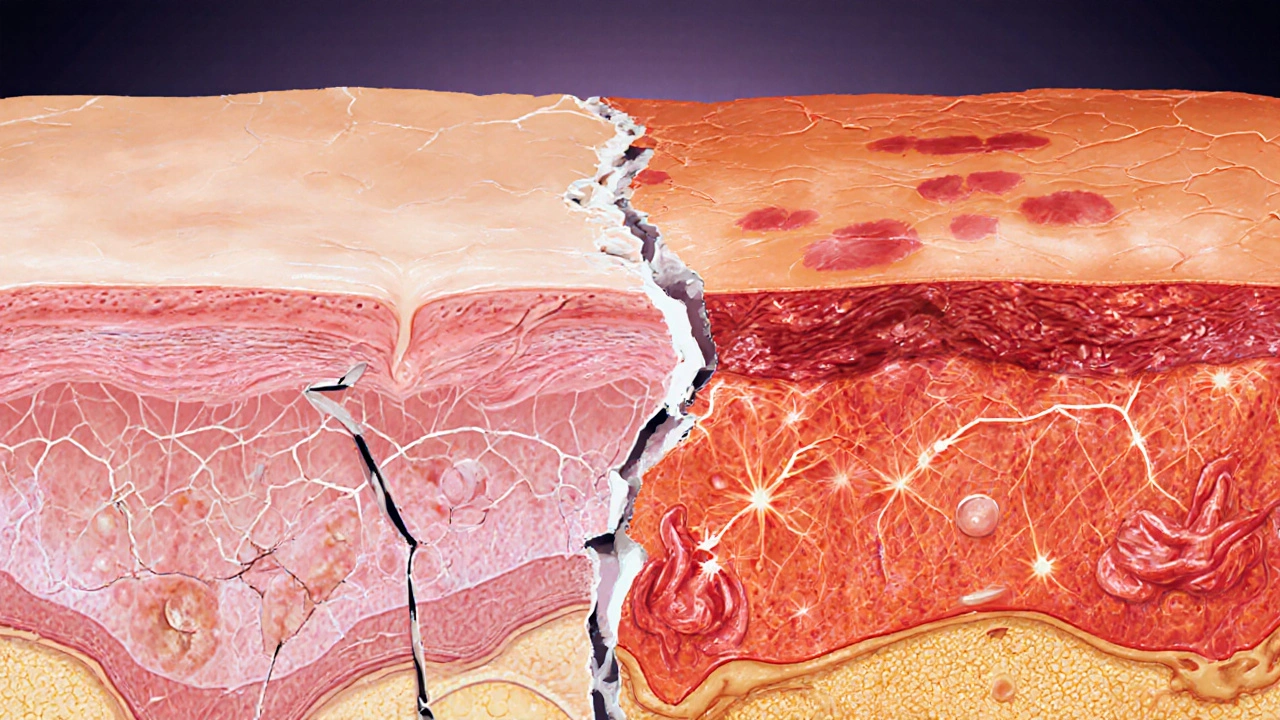Contact Dermatitis & Skin Aging Risk Calculator
Select potential triggers that apply to your daily routine:
Quick Takeaways
- Identify common irritants and allergens early.
- Strengthen the skin barrier with the right moisturizers and barrier creams.
- Shield your skin from UV radiation and oxidative stress.
- Use a simple daily routine that blends cleansing, protection, and repair.
- Know when a dermatologist’s advice is needed.
What is Contact Dermatitis?
Contact dermatitis is an inflammatory skin reaction that occurs when the skin comes into direct contact with an irritant or an allergen. It shows up as redness, itching, swelling, and sometimes blisters. The condition can be acute-appearing within hours-or chronic, persisting for weeks if the trigger isn’t removed.
Two main types exist:
- Irritant Contact Dermatitis: caused by chemicals like detergents, solvents, or even frequent hand‑washing with harsh soaps.
- Allergic Contact Dermatitis: driven by an immune response to substances such as nickel, fragrance compounds, or latex.
Both types compromise the skin’s natural barrier, making it easier for moisture to escape and for external aggressors to slip in.
How Skin Aging Interacts with Contact Dermatitis
When the barrier is broken, the skin loses water faster, which accelerates the formation of fine lines and loss of elasticity-key signs of skin aging. Inflammation also triggers the release of enzymes that break down collagen and elastin, the proteins that keep skin firm.
Studies from dermatology clinics in the UK show that patients with a history of chronic contact dermatitis develop visible aging signs up to 10 years earlier than age‑matched controls. The combination of repeated inflammation and impaired barrier function creates a perfect storm for premature aging.
Everyday Protection Strategies
Protecting your skin is about three core steps: clean, protect, and repair.
1. Gentle Cleansing
Choose a pH‑balanced, fragrance‑free cleanser. Harsh soaps strip natural lipids and worsen irritation. A good rule of thumb is to limit washing to twice a day unless you’ve been exposed to a known irritant.
2. Reinforce the Barrier
Two product families work best:
- Moisturizer: usually contains humectants like glycerin or hyaluronic acid that pull water into the skin.
- Barrier Cream: richer formulas with occlusive agents (petrolatum, dimethicone) and lipids (ceramides) that seal the barrier.
Apply while the skin is still damp-this traps extra moisture and maximizes absorption.
3. Shield from UV and Oxidative Stress
Even on cloudy days, UV‑A rays penetrate and generate free radicals that degrade collagen. A broad‑spectrum sunscreen with at least SPF30 is non‑negotiable. Look for added antioxidants like vitaminE or green‑tea extract; they neutralize free radicals before they can cause damage.
4. Identify and Avoid Triggers
Keep a simple diary: note any new soaps, cosmetics, or workplace chemicals you’ve used. If a rash appears, stop using the suspect product for at least 48hours and see if the skin improves. Common culprits include:
- Nickel in jewelry
- Fragrance mixes in personal care items
- Gloves made of latex
- Industrial cleaners containing solvents

Product Comparison: Moisturizer vs Barrier Cream
| Attribute | Moisturizer | Barrier Cream |
|---|---|---|
| Primary Goal | Attract water to the skin (humectant) | Seal in moisture and protect against irritants (occlusive) |
| Typical Ingredients | Glycerin, hyaluronic acid, panthenol | Petrolatum, dimethicone, ceramides |
| Best For | Dry, normal, or mildly irritated skin | Severe irritation, occupational exposure, eczema‑prone skin |
| Frequency of Use | Morning & evening | After every wash or whenever skin feels tight |
| Texture | Light, fast‑absorbing | Thicker, may leave a subtle film |
Lifestyle Tips that Complement Skincare
Beyond products, everyday habits matter a lot. Here are three evidence‑based tweaks:
- UV Radiation protection: Wear wide‑brim hats, sunglasses, and UPF clothing when you’re outdoors for extended periods.
- Boost internal antioxidants: Foods rich in vitaminC, vitaminE, and polyphenols (berries, nuts, leafy greens) help combat oxidative stress from the inside.
- Stay hydrated: Aim for at least 1.6L of water daily; well‑hydrated skin recovers faster from irritant exposure.
When to See a Dermatologist
If you notice any of the following, schedule a professional appointment:
- Rash that spreads beyond the initial contact area.
- Blisters that ooze or crust over.
- Painful itching that disrupts sleep.
- Signs of infection: redness expanding, warmth, pus.
Dermatologists can perform patch testing to pinpoint specific allergens and may prescribe topical steroids or barrier repair prescriptions, such as ceramide‑rich ointments, for faster healing.
Putting It All Together: A Simple Daily Routine
- Cleanse with a fragrance‑free, pH‑balanced wash.
- Pat skin dry, leaving it slightly damp.
- Apply a moisturizer in the morning; if you work with chemicals, follow with a thin layer of barrier cream.
- Finish with a broad‑spectrum SPF30+ sunscreen that contains antioxidants.
- In the evening, repeat steps 1‑3, swapping sunscreen for a night‑time barrier cream if needed.
Stick to this routine for two weeks and watch the redness subside, while your skin feels smoother and looks less aged.
Frequently Asked Questions
Can I use the same product for both contact dermatitis and anti‑aging?
Yes, if the product is fragrance‑free, contains ceramides, and offers UV protection. A barrier cream with SPF works well for both concerns.
How long does it take to see improvements after switching to a barrier cream?
Most people notice reduced redness and tighter skin within 3‑5 days. Full barrier restoration can take 2‑3 weeks of consistent use.
Are natural oils (like coconut or olive oil) good for contact dermatitis?
Some oils can be irritating for sensitive skin, especially if they’re not refined. Look for hypoallergenic, dermatologically tested oils if you want a natural option.
Do I still need sunscreen if I’m staying indoors most of the day?
Yes. UV‑A rays penetrate windows, and indoor lighting can emit low‑level blue light that contributes to oxidative stress.
What’s the best way to test if a new product triggers my dermatitis?
Apply a small amount to a hidden area (like behind the ear) for 48hours. If no reaction appears, it’s likely safe to use on larger areas.




Emer Kirk
October 3 2025I feel like my skin is crying for help